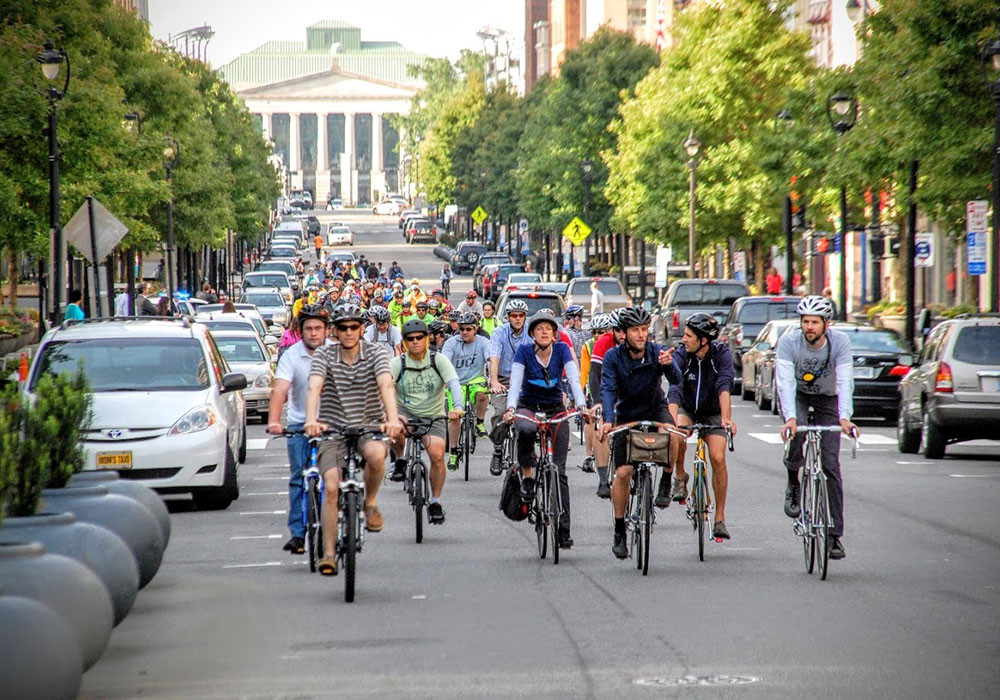Fayetteville Street, stretching just under half a mile, serves as the historical and cultural epicenter of downtown Raleigh, North Carolina. Rooted in the city’s original 1792 plan by William Christmas, Fayetteville Street has been integral to Raleigh’s growth and economic prosperity. Through thoughtful urban planning, Fayetteville Street underwent a remarkable transformation from a neglected pedestrian mall to a vibrant, open street distinguished by unique streetscape elements.
 Family enjoying an event on Fayetteville Street Mall in Raleigh NC, showcasing its pedestrian-friendly design.
Family enjoying an event on Fayetteville Street Mall in Raleigh NC, showcasing its pedestrian-friendly design.
The bustling atmosphere of Fayetteville Street is a testament to the collaborative efforts of city officials, planners, designers, and community members. Initially, in 1977, Fayetteville Street was converted into a pedestrian mall, mirroring a popular trend at the time. While intended to create open space, the mall unfortunately became desolate after business hours. This underutilization discouraged businesses and restaurants, contributing to a sense of downtown emptiness and insecurity. In response, the Raleigh Department of City Planning developed the Livable Streets Plan in 2003, prioritizing the Fayetteville Street Renaissance as a key initiative to revitalize downtown.
After years of meticulous planning and construction, Fayetteville Street was reopened to vehicular traffic in 2006 and has since flourished as the heart of downtown activity. The redesigned street boasts the widest sidewalks in downtown Raleigh, complemented by abundant seating, street trees, and distinctive, colorful stone pavers at intersections. These design choices create a safe and inviting environment for pedestrians and cyclists, seamlessly connecting residents and visitors to nearby attractions such as public plazas, parks, a library, and a modernized transit station serving both local and regional destinations.
 Cyclists riding on Fayetteville Street in Raleigh NC, highlighting its design for slow vehicle speeds and group events.
Cyclists riding on Fayetteville Street in Raleigh NC, highlighting its design for slow vehicle speeds and group events.
Since its transformation from a pedestrian mall to a ceremonial Main Street, the Fayetteville Street area has attracted over $2 billion in public and private investments, including the construction of Raleigh’s tallest skyscraper.
Defining Characteristics and Features
Fayetteville Street offers a unique blend of features that contribute to its success:
- Proximity to an Amtrak train station, promoting diverse transportation options.
- Lively street activity throughout the day and night, extending beyond typical business hours.
- A diverse mix of businesses, including restaurants, bars, art galleries, and retail shops.
- The presence of Sir Walter Raleigh apartments, providing low-income senior housing within Raleigh’s oldest surviving hotel building.
- City Plaza, located at the end of Fayetteville Street, hosting popular events like the Raleigh Downtown Farmers Market during summer.
- Recognition as part of the National Register of Historic Places in 2008, with historic facades from the 1870s to 1960s providing a culturally rich backdrop.
By the Numbers
- In 2017, the planning department conducted a “100 meetings in 100 days” campaign, with many meetings held along Fayetteville Street, encouraging public engagement in city planning.
- Over 1,000 individuals participated in meetings, workshops, and visioning sessions organized by the Downtown Raleigh Plan.
Designated Area
The revitalized Fayetteville Street spans from West Morgan Street to West Lenoir Street.
 Fayetteville Street in Raleigh NC with wide sidewalks, seating, and street trees, demonstrating its bustling environment day and night.
Fayetteville Street in Raleigh NC with wide sidewalks, seating, and street trees, demonstrating its bustling environment day and night.
Learn More
2030 Comprehensive Plan (2009)
Raleigh’s Streetscape Renewal, Part of an Integrated Effort to Transform Downtown
